Greece. The place of sun, sea and beaches right?!
No, not always. Greece is actually a very mountainous country, especially the mainland. A lot of the mountains are typical Mediterranean, bushy and arid with not much in terms of features. However there are some distinctly amazing areas where the mountains differ a lot. One of the highlights has got to be the Zagoria region near Ioannina in North-West Greece. The other highlight is Meteora near Trikala.
These two areas caught my attention around 5 years ago and 3 years ago I made an effort to visit them in August. I wrote a blog about that visit here. Unfortunately, we went in August and it was too hot and too dry to do some of the things we wanted to do, including hiking up to the Astraka Refuge Hut.
Since then, I had been itching to go back and finish what I had started. I never quite found the time, but this year I was determined. I had started planning and knew ideally I needed to go late May. I came close to booking to go solo but I actually found a willing friend to join me. I don’t mind doing things on my own, but having a friend with you really adds a social element and can keep you sane for the week, especially if the weather turns for the worst or you relax outside of the golden hours. So I booked and started to get a plan together.
My main objective of the trip would be to visit the Astraka Refuge and the mountains surrounding it. The great thing about this area is that not many photographer’s have explored it, especially those who aren’t Greek. There’s a certain allure to that kind of photography for me. What I really wanted to do as well was showcase a different side to a country that people just wouldn’t expect. So, back to the refuge, this building sits around 1920m high up above Mikro Papigo and provides a great base camp for exploring the mountains around it. At this altitude, the scenery really starts to change and things become more rugged, alpine and very dramatic. One of the highlights of the area has to be Drakolimni, an alpine lake looking over towards the impressive Astraka mountain. For the second part of the week, I was to return to Meteora. The refuge has it’s own website with some awesome 360 panoramics to give you an idea of the area. http://www.astrakarefuge.com/en/
So, we had flown to Thessaloniki and drove 4 hours to the Zagoria region. The forecast for the week had started to look pretty dubious and as we gained height, the clouds rolled in, capping the mountains and we saw a few bolts of lightning fire off. A daunting prospect when your plan is to head high up. The sunset was late, around 9pm but we had booked into a hotel in Mikro Papigo that allowed check-in until midnight. Despite feeling tired, we decided not to take the easy route out and instead headed for sunset at Vikos Gorge. I had been to this location on a previous visit but hadn’t had a cloud in the sky and I wanted to return hoping for a little more luck. Luckily (and purposely chosen for this reason) the walk from Vradeto to Beloi isn’t too bad. We actually parked at the end of the dirt track and the walk is probably 15 minutes at most.
It was a surreal difference to the last time I was here. Gone was the dry grass, replaced by a fresher smell with wild flowers I hadn’t seen before. It caught me so much by surprise, I didn’t even bother to put on my walking shoes which was a big mistake as the rain had created muddy paths and lethal limestone. On arriving at the viewpoint I hadn’t quite got the same shock I had last time, with drops in places of around 1000m making me feel dizzy but I was still very impressed and glad to be there. The last time I had found a composition a little too late, after the sun had gone down and I didn’t make the same mistake twice and scrambled up to the higher viewpoint where not many people venture.
I spent a little time, trying different compositions. A large cloud hung over Timfi, the mountain range where Astraka resided. This first shot was my favourite of the evening, I loved the wild flowers adding a little colour to the scene and the foreground rocks just helping to give a little scale to that huge drop:
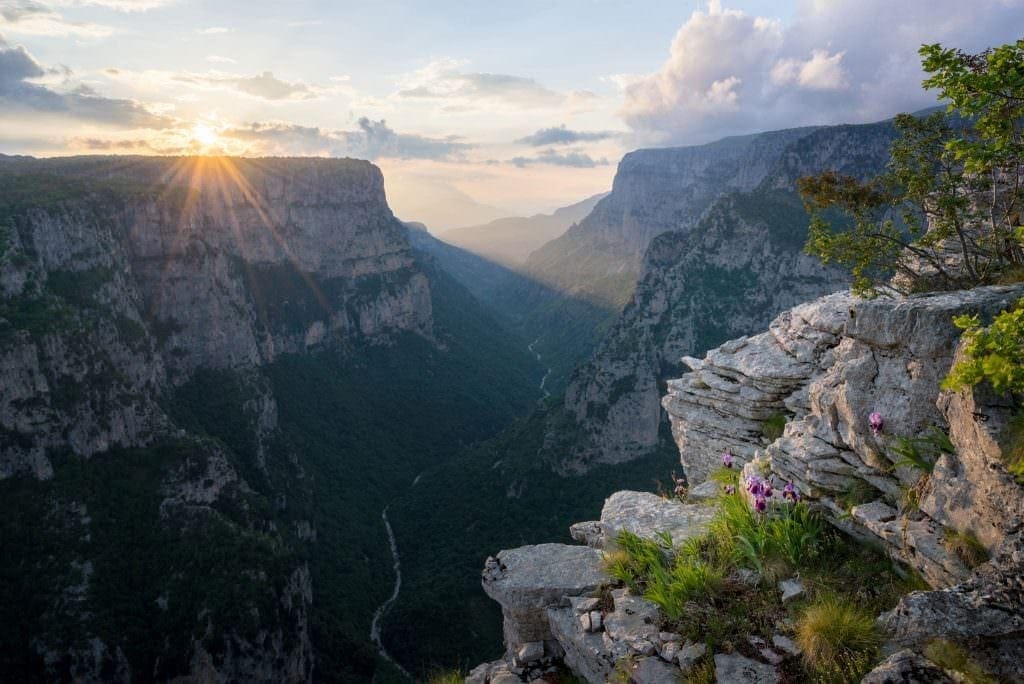
I moved back up top and also shot a similar scene but this was the original composition I had in mind which I had spotted a few years back:
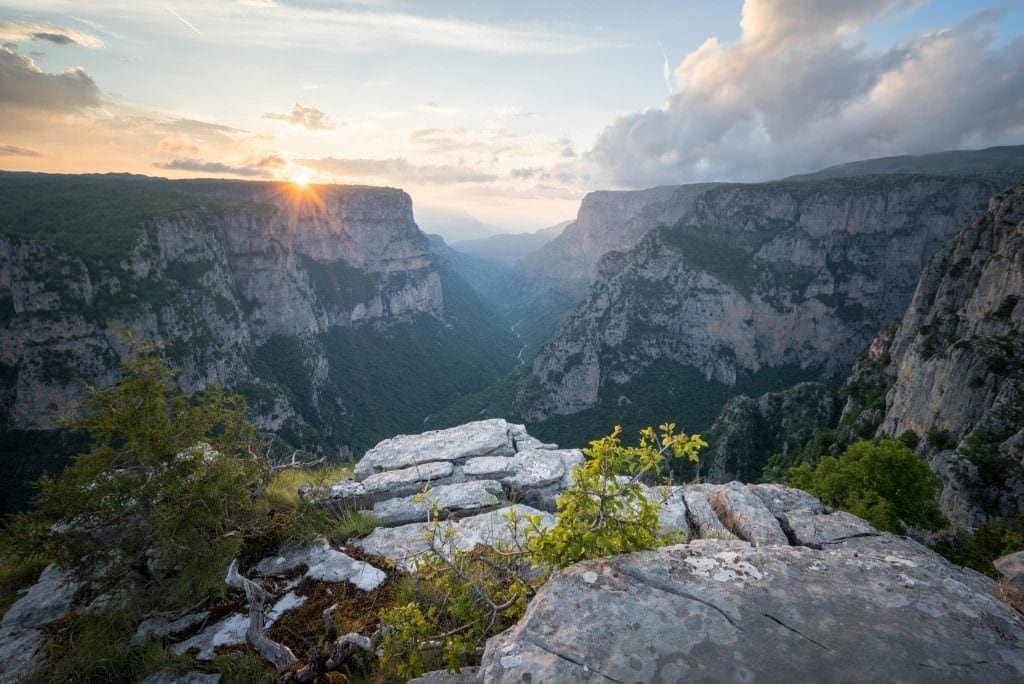
Finally, once the sun had gone behind the cliff I whipped the telephoto lens out and zoomed far into the valley, with the light nice and orange. The scene was quite hazy in all but it had a nice dreamy feel to it.
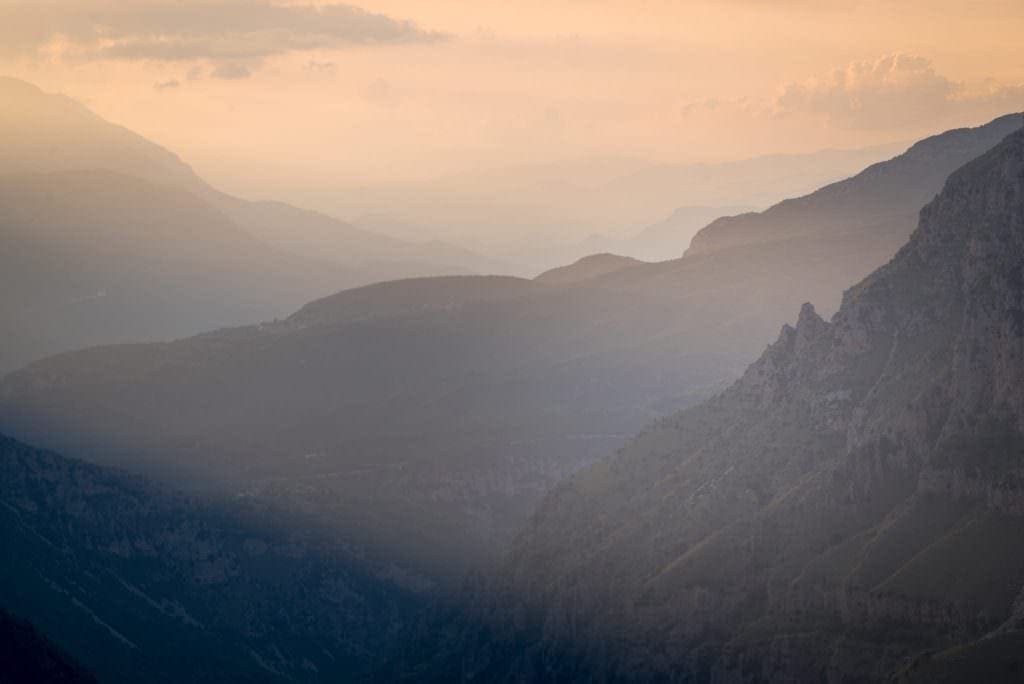
I was at this point pleased to have improved on the photos I had taken last time but I was also feeling shattered from the long day. Unfortunately, it was another hour or so to the hotel. While, on the map it was only 5 miles away, the village was across the gorge and you simply can’t drive across! So, you have to take many steep and windy mountain roads to get there. We arrived in Mikro Papigo very late and didn’t have a clue where the hotel was. The village itself is pretty much car-free due to tight and narrow roads (we found this out the hard way) but after a quick call to the hotel we were soon in our room getting ready for the next day.
We woke the next morning and checked the forecast. It said thunderstorms were due to roll in, but sitting in the early morning sun it was hard to believe. We packed slowly and probably headed off a little later than we should have. We decided to leave the tents and instead take up the drones. With the forecast, being in a tent probably wasn’t going to be the best of ideas. We had 950m to ascend but we weren’t sure on the mileage, just that it would be 2hr50 (a European thing). The trail was fairly good and even though it was steep in places, it wasn’t actually too hard or too much of a chore and me made it in 2hrs20. Shelters and springs are along the way and if you so wish, you can even have a mule carry your equipment (we didn’t). We had a few local guides express concern on our way up due to thunderstorm risk but we decided to carry on and if it turned for the worst, we would turn back. We got to the refuge fine and it was actually the first time I had stopped in one. We met the guy who ran the refuge, who stays there from May until October. He explained the facilities and rules to us and it was perfect. I was disappointed looking down into the basin below where the lake at Xeroloutsa had pretty much dried up. May is usually a good month to shoot the lake before it dries up (the refuge didn’t open until mid-May anyway). I had been hopeful as I knew they had a harsh winter, but it turns out they also had a very dry spring despite snow up the mountain until mid-April.
I felt sweaty from the walk, so went to take a cold shower (the only kind in the refuge!) and came out with a head that hurt and fingers I couldn’t feel it was that cold. Proper mountain water I guess! As I was drying off, the rain started to lash down and I saw a bolt of lightning in the not too far distance and from the direction of the way we had come up. We had timed it just right.
That was it for the evening, the rain persisted and the cloud had come in. No photography to be done. I had gathered a rough idea of where Drakolimni was during the brief period of visibility but knew it might be a tough walk to find the next morning in the dark. I awoke at 4am and was disappointed to wake up to more clag, with no sign of it clearing. Back to bed it was and we got up later that morning. The weather started to clear a little just after breakfast. We took the drones out and did a bit of video and photos. This first image is of Astraka mountain:
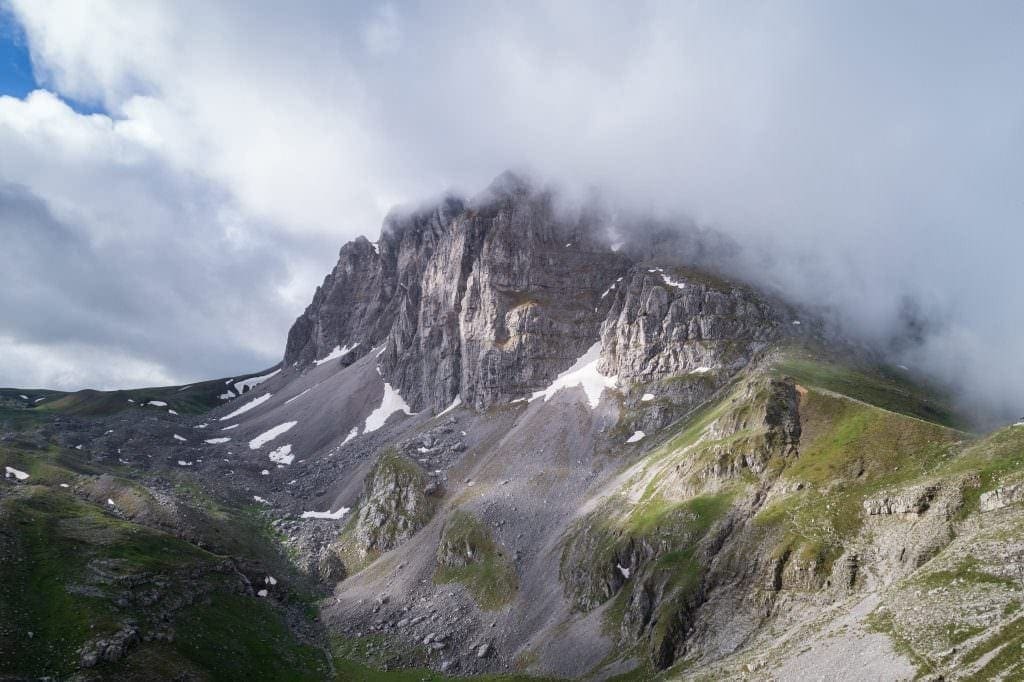
This next shot shows the location of the refuge against the beautiful mountain backdrop:
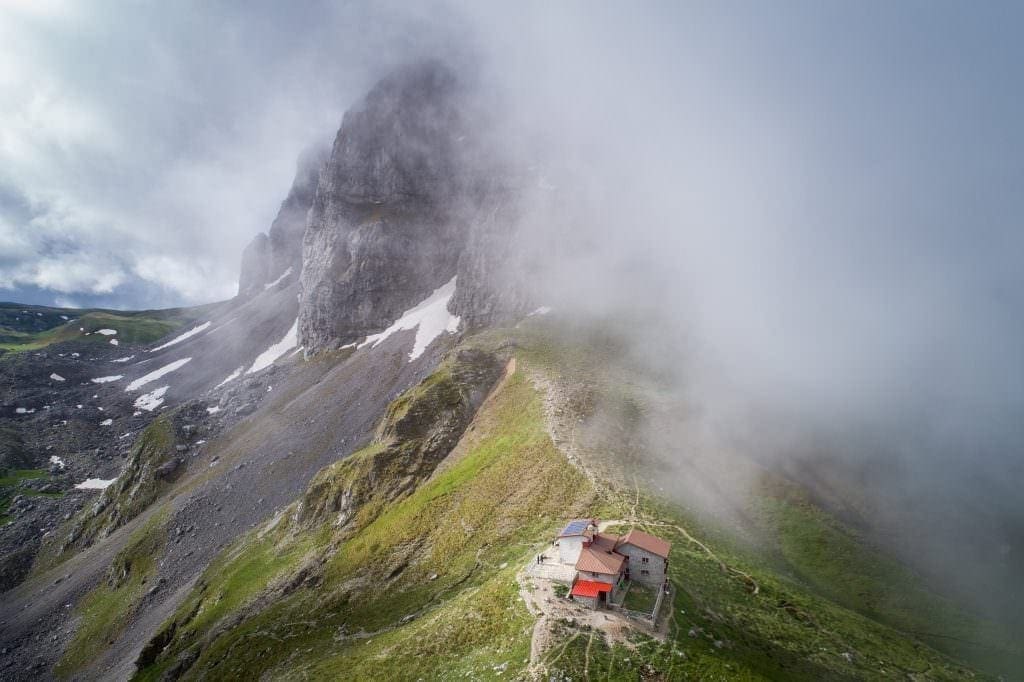
After this we decided to do a reccy trip up to Drakolimni. It actually turned out to be our only real break in the weather while up there. With the cloud floating around, there was still enough drama to take a shot and it helped diffuse the light a little.
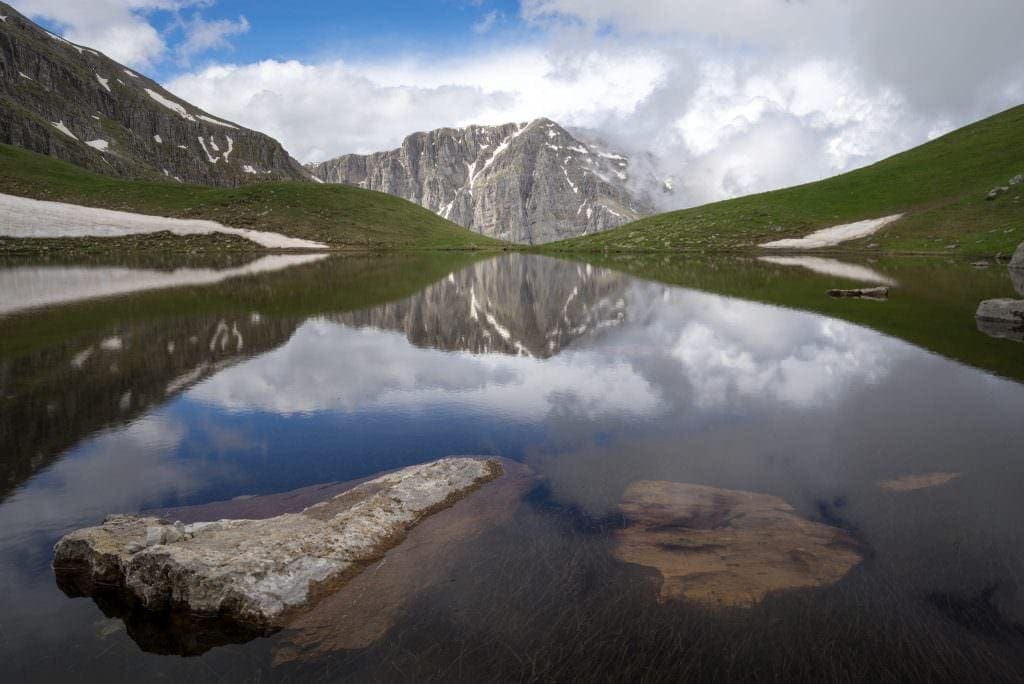
The lake sits under the flanks of Gamila, the highest peak in the area, but looks over to the more recognisable and more aesthetically pleasing Astraka. The walk from the refuge involves a large descent of around 250m into the alpine basin, where we walked through lush green meadows, amongst alpine flowers before ascending again to nearly 2000m where the lake sits. The lake is mythical and folklore says it was once inhabited by dragons who would used to fight. Nowadays, the only kind of dragons left are small alpine newts.
We spent a total of 3 days up at the refuge. By this point we were a little frustrated with the uncharacteristic weather and was becoming rather tired. We considered staying another night but the forecast was still hit and miss. We decided we would be best to descend and to move on to Meteora. Maybe we would have better luck there.
We descended down the mountain quickly on our way back and before we knew it we were in Mikro Papigo, having breakfast at the hotel we had stayed in days before. In the valley it was sunny and warm but looking up to Astraka, the clouds still hung around and we felt we had done the right thing. It’s always hard to leave something behind, but you just need to tell yourself it will always be there. Staying would inevitably frustrated us more.
We had a little bit more of an explore of the Zagori region, checking out some of the stone bridges and also the rock pools near Papigo. Here is a reference shot of the arched bridges at Kipi I took:

We then made our drive over to Meteora. It was just over 2 hours away and we passed through more rain and thunderstorms. Would it ever relent?
I love Meteora, it was one of the big focuses of my last trip to Greece and I actually didn’t feel the need to get too many photos here as I had been happy previously. For those that don’t know, this little area just north of Trikala has giant sandstone monoliths that rise sharply out of the valley. If that wasn’t unique enough, monasteries have been constructed atop of many of these monoliths. An impressive feat and it’s no surprise its a UNESCO world heritage site and also used briefly in Game of Thrones.
One thing I had noticed since my last visit is that it had become even more popular, especially with tourists and we knew sunsets was going to be difficult. There’s still not an abundance of photographer’s which is nice but there were more than last time. We only saw one tripod on our last visit. Our first evening wasn’t to be, the clouds and rain had followed us. I always get obsessive when I make a decision to leave somewhere, trying to check webcams and satellite data to see if we had made the right choice in leaving. I find it hard to let go I guess and this would be the theme of my next few days. But back to the here and now, lightning would strike in the distance but we weren’t able to capture it. Soon the rain would hit us and have us retreating. I did manage a shot before it reached though, showing it sending an absolute dumping in the distance:

That evening the rain really gave it some while we were having food at the local restaurant. I had been advised May was a good time of year for photography in the area, especially Zagoria but I was starting to doubt. I was all for clouds, drama and the odd bit of rain but not this much. One of the waiters spoke to us and said it was very unusual. He commented usually they would get a day or two with some periods of heavy showers but not the extended period like they had. Just my luck I guess! That’s sometimes the problem with mountainous weather, even in hot countries, the weather can be unreliable.
One photo that did elude me on my last trip to Meteora was of Paliokarias waterfall which is about 30 minutes away on the other side of Trikala. We had visited the waterfall but it was almost dry being the height of August. Thankfully this time, and probably thanks to the amount of rain, the waterfall was in full flow. Paliokarias waterfall is actually quite tricky to find, most directions aren’t clear and people who have pinned it on Google haven’t got the location right. Last time we nearly gave up after a couple of hours and even on my return, due to it being 3 years later, my memory failed me and we still took a few wrong turns. Thankfully, I have now pinned it for myself for my future visits.
The waterfall is awesome, this large fall is actually man-made, flowing under an impressive and large brick arched bridge. Very characteristic. Most people who came to see it were Greek, you certainly got the impression it was a local secret, which is kind of nice. To get a composition of the waterfall is difficult, Include the bottom of the falls in and the whole thing loses its sense of scale. Instead, I opted to include some of the lower falls and thought a telephoto shot would lend itself better to try and preserve some scale. I took off my trainers and got myself into the centre of the river to really help my composition. Unfortunately, the waterfall are slightly at an angle to each other, so you can’t quite make them look straight but I assure you, my horizon was 100% spot on!
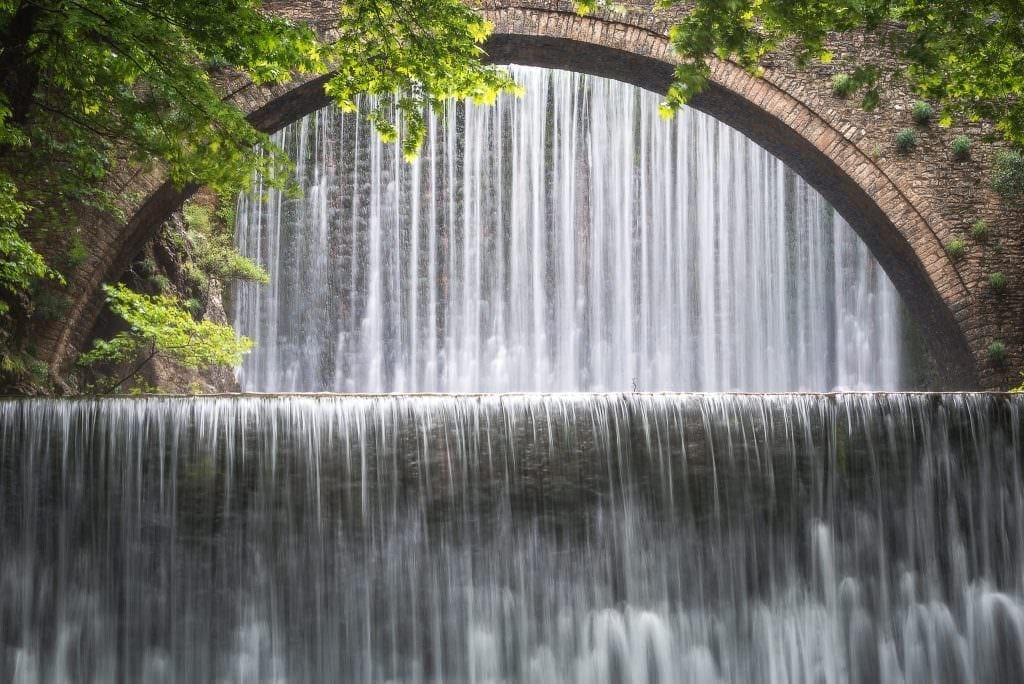
At least that was another image ticked off the list. I felt a bit better now. The sunset that evening didn’t happen, I don’t have much memory of it except that it was probably dull. It had rained a fair bit that day. The next morning we got up for sunrise. We then spent a day hiking around Meteora. The weather had become a lot better and much more Greek. It was a great opportunity to reccy more viewpoints to take some photos, maybe on future trips and workshops. We knew if we wanted to capture sunset, we would need to be at the viewpoint early to secure our spot. We arrived two hours before sunset and were one of the first there, phew. It soon filled up and we were smug for getting prime position. The sunset was actually pretty stunning and even though I felt I didn’t need another shot, I was actually very glad to have better conditions. I decided to try and take a panoramic and I thought I’d use my newly acquired Sony 55mm lens. It’s not a focal length I would usually use, but actually it really worked well with the panoramic and I loved the result I got. This is perhaps a photo I’d actually like to get printed large for my own wall. Click the photo to view it large.

We knew we could leave the area content and happy, there simply wasn’t anything else left to capture. We decided rather than rush for the flight on the last day, we would head to Thessaloniki for a relaxing day and check into a hotel near there. Typical, the day before we leave and the temperatures picked up to 30c. Sometimes you just never know.
I also put together a short aerial video showcasing some of the locations from my time there, you can view that here:
Thank you for reading. If you liked what you saw and would like to join me next May on a workshop here, with hopefully much better weather that is typical of the time of year, then head to the workshop page here to find out more information.
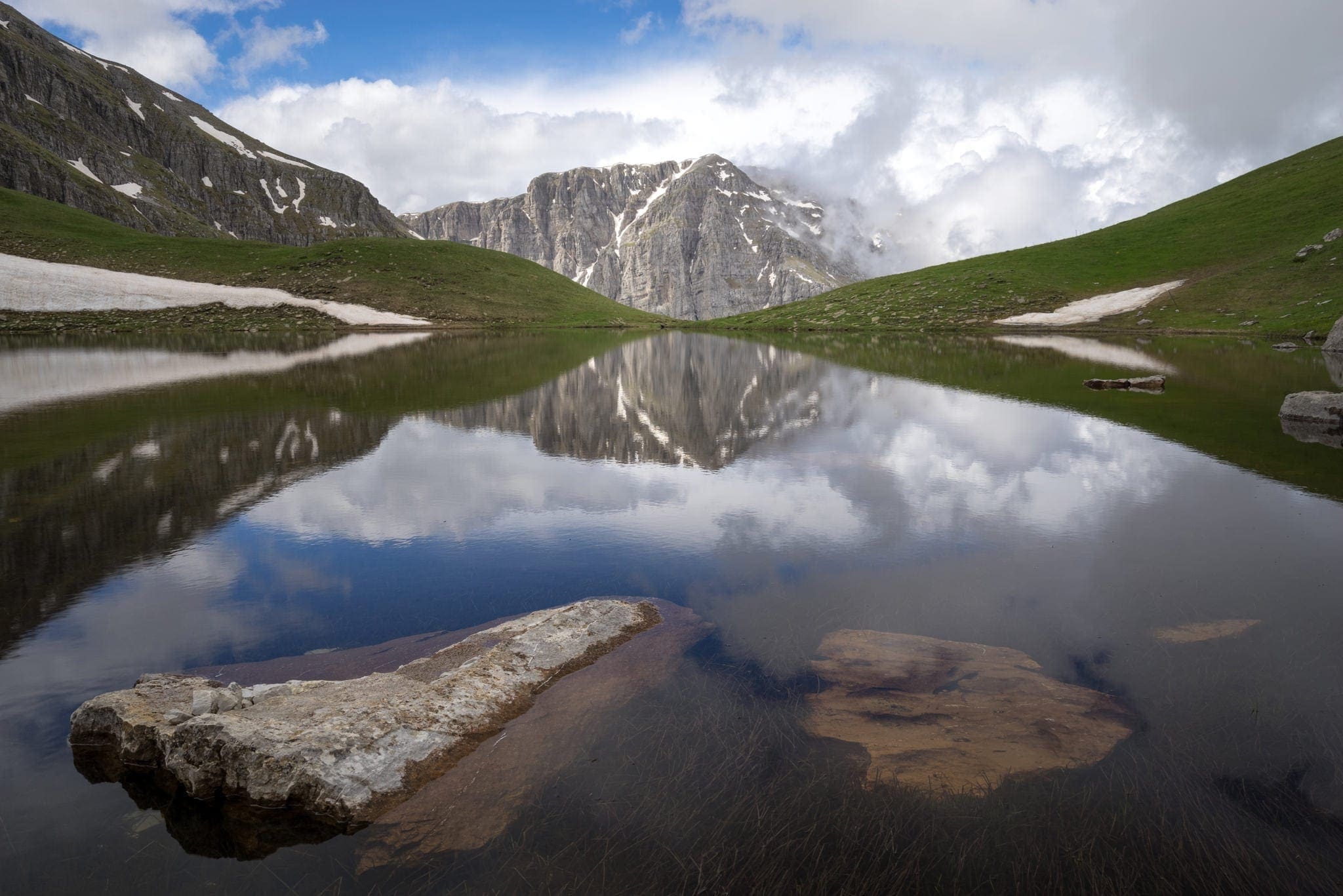
Excellent article James, well written and really interesting. I haven’t been to Greece but the weather you experienced was a big surprise (more so for you though!) as I thought it was a place of blue sky and blazing hot sunshine, how wrong was I!!!
The refuge sounds like a great location for photographers and the images you posted were superb, I can see why you like the area so much. Do you have to reserve beds at the refuge or is it first come, first served basis?
Have you considered running one of your workshops and use the refuge as a base?
Take care mate and say hi to Sarah for me please. ??
Hi Andy,
You and me both were wrong!
You can ring up in advance before you make the trek up. It wasn’t busy when we went but I can imagine it gets busy in summer, even though the area will be so much drier and more boring and too hot too walk!
Yes I’ll be running a workshop next year, are you going to be fit and well enough to come? 😉
I would love to mate but hopefully we will be busy moving! ???
Very interesting account. I went to this area some time ago and my trip was ruined by the very unfriendly sheepdogs (I wasn’t the only one) so good to see that you made it unscathed!!